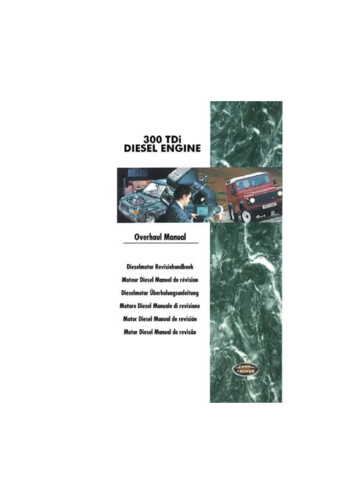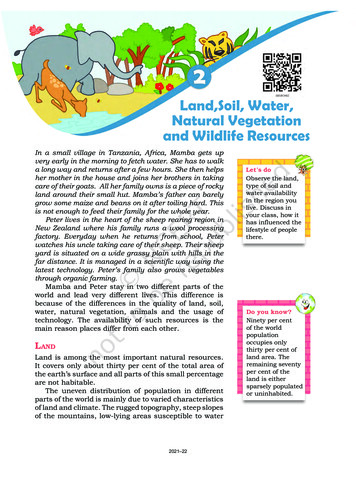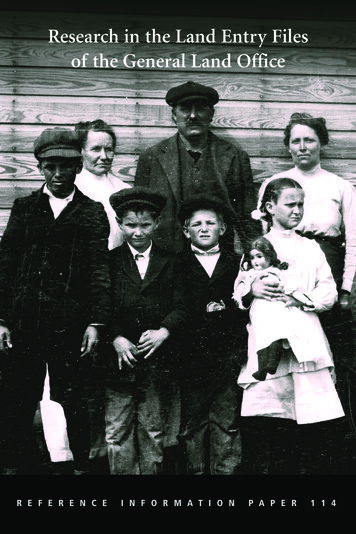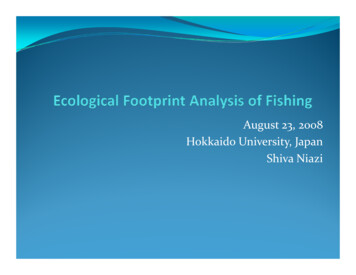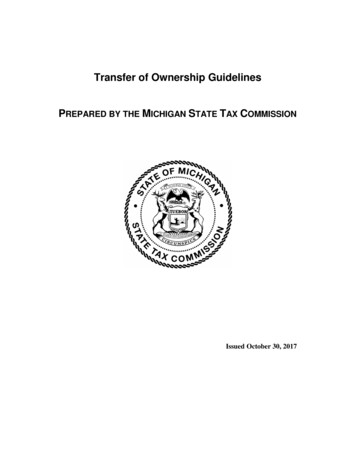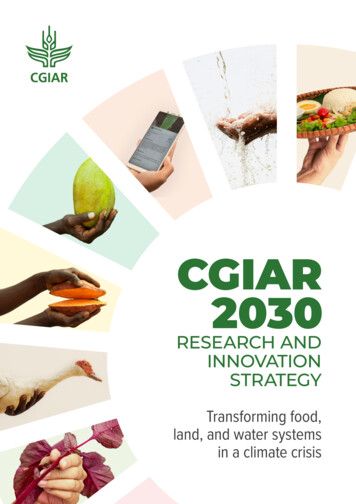
Transcription
Transforming food,land, and water systemsin a climate crisis
www.cgiar.org
Transforming food,land, and water systemsin a climate crisis
Jacquelyn Turner/CCAFS
Contents8 Executive summary10 Part 1. Why a new strategy to 203011 A new strategy to address new challenges14 One CGIAR creates a new opportunity16 Part 2. What CGIAR will deliver17 CGIAR’s vision, mission, intended impacts, andportfolio of research and innovation22 Action Area on Systems Transformation24 Action Area on Resilient Agrifood Systems26 Action Area on Genetic Innovation28 Part 3. How CGIAR will implement this strategy
The CGIAR 2030 Research andInnovation Strategy in a nutshellCGIAR research and innovation will:Nutrition, Health, and Food SecurityAchieve positivemeasurablebenefits across5 Impact Areas ImpactAreasPoverty Reduction, Livelihoods, and JobsGender Equality, Youth, and Social InclusionClimate Adaptation and Mitigation5 ImpactAreaplatformsEnvironmental Health and Biodiversity by scaling researchand innovation ImpactPathways delivered throughregional and globalCGIAR Initiatives CapacityDevelopmentInnovationsPolicyCountryand regionalengagementInitiativesActionAreas that draw on global,best in class, capabilitiesand ways of working icInnovationSystems TransformationStrategic AlliancesWays ofWorkingPerformanceand ResultsManagementFrameworkMultiple PathwaysRisk and ResilienceInnovative FinanceDigital Revolution collaborating closelywith partners in all researchand innovation for impact.6 CGIAR 2030 RESEARCH AND INNOVATION STRATEGYPartners3 ScienceGroupsthat deliverAction Areas
Chris de Bode/CGIARCGIAR 2030 RESEARCH AND INNOVATION STRATEGY 7
Executive summaryWhy a new strategy to 2030Food unites the world, and powers us forward.Today a powerful and unified global effort is neededto equip food systems to advance human andplanetary health to their full potential. The climatecrisis is at the forefront of threats to our ability toprovide good nutrition for all people while stayingwithin environmental limits. Interlocked with climatechange are land degradation, deforestation, lossof biodiversity, depletion of water resources, andpollution. These threats to our planetary life supportsystems in turn propel poor health, economicinequality, social upheaval, and conflict. Foodsystems are both a driver and a victim of thesechallenges.Yet — if managed and governed differently — foodsystems could be a champion of change, at thevanguard of sustainable living for all, leading othersectors with solutions and inspiration. A radicalrealignment of food systems around the worldcould accomplish not only an end to hunger andmalnutrition in all its forms, but also gender equality,job creation, prosperous livelihoods, opportunitiesfor youth, climate solutions, and environmentalhealth.Multiple like-minded partners are now workingtowards this vision at all levels from local to global— with practical ideas on how to catalyze systemstransformation with breakthroughs both smalland large. Science and innovation are a criticalpart of the mix, providing new evidence, insights,and solutions that feed into strategic alliances forchange.CGIAR, as the world leader in agricultural scienceand innovation for development, must now stepup to be a key player in global food systemstransformation. The intertwined health, environment,and social inclusion challenges of the 21st centurycreate an urgent impetus to sharpen the focusof CGIAR research. A refreshed, more ambitiousstrategy from CGIAR provides an opportunity toaccelerate achievement of systems resilience andequal opportunities.A new transition to One CGIAR — the integrationof CGIAR’s capabilities, knowledge, assets, people,and global presence for a new era of interconnectedand partnership-driven research towards achievingthe SDGs — provides the opportunity for a fresh10-year strategy that can shape a stronger and morerelevant science agenda for today’s dynamic world.One CGIAR enables us to operate as a cohesive8 CGIAR 2030 RESEARCH AND INNOVATION STRATEGYorganization with a single mission, seamlesslyleveraging all of our capabilities and assets todeliver real benefits to people and our planet.This 2030 Research and Innovation Strategysituates CGIAR in the evolving global context thatdemands a systems transformation approach forfood, land, and water systems. It builds on our trackrecord of collaborating with partners to deliverimpacts for more than 50 years, lifting hundreds ofmillions of people out of hunger and poverty andsupporting low-income producers and consumers.Through integrated systems research, One CGIARand country partners will strive for impact to createsustainable and resilient food, land, and watersystems, and meet SDG targets.This Strategy presents CGIAR’s ambitious high-levelapproach for making a significant and meaningfulcontribution to the transformation of the world’sfood, land and water systems — both towards andbeyond the SDGs, providing science of relevancewithin and beyond the Strategy’s 2030 horizon. Itprovides an overview of how CGIAR will developand deploy its capacities, assets, and skills toaddress priority global and regional challengeswith partners. The strategy covers all research fordevelopment programming across CGIAR. ThisCGIAR 2030 Strategy will be delivered through3-year Investment Plans, which will frame CGIARwork supported by pooled funding of large CGIARInitiatives. These Investment Plans will providea much greater level of detail on the objectives,targets, activities, deliverables, and budgets ofCGIAR Initiatives based on detailed co-analysisand co-design together with global, regional, andnational partners, and investors.What CGIAR will deliverTo achieve its mission — to deliver science andinnovation that advance transformation of food,land, and water systems in a climate crisis — CGIARwill design its work with partners to realize multiplebenefits and transformative change across fiveSDG-focused Impact Areas: (i) Nutrition, health, andfood security; (ii) Poverty reduction, livelihoods, andjobs; (iii) Gender equality, youth, and social inclusion;(iv) Climate adaptation and mitigation; and (v)Environmental health and biodiversity. Recognizingthe need to accelerate global progress towardsthe SDGs, CGIAR will invest in technological andinstitutional innovations, partnerships, capacitydevelopment, and policy engagement across all fiveImpact Areas.
CGIAR will strive for impact at scale globally andregionally by organizing along three Action Areas inwhich accelerated innovation is required to createsustainable and resilient food, land, and watersystems and to meet SDG targets. The Action Areasare: (1) Systems Transformation; (2) Resilient AgrifoodSystems; and (3) Genetic Innovation.The 2030 Research and Innovation Strategy sets thestage for doing business differently to ensure thatresearch provides real solutions for development.CGIAR will change the way it works, following sevennew implementation approaches.HOW THE STRATEGY WILL BE IMPLEMENTED1Embrace a systems-transformationapproach, seeking multiple benefitsacross five SDG-linked Impact Areas2 Leverage ambitious partnerships forchange in which CGIAR is strategicallypositioned3 Position regions, countries, and landscapesas central dimensions of partnership,worldview, and impact4 Generate scientific evidence on multipletransformation pathways5 Target risk-management and resilienceas critical qualities for food, land, andwater systems6 Harness innovative finance to leverage anddeliver research through new investment, andfunding models7Make the digital revolution central to ourway of workingThe interrelated elements of the 2030 Research andInnovation Strategy, including its functions and thestructure for delivery, are outlined in the infographicon page 6. Neil Palmer/CIATCGIAR 2030 RESEARCH AND INNOVATION STRATEGY 9
PART 1Why anew strategyto 203010 CGIAR 2030 RESEARCH AND INNOVATION STRATEGY
A new strategy to addressnew challengesFood unites the world, and powers us forward. Drivenby agricultural productivity growth, humanity has madetremendous strides in reducing poverty and food insecurityover the last decades. Now food systems must step up toaddress a daunting array of global issues. Foremost amongthese is the climate crisis, which poses an existential threat tohumanity. Yet — if managed and governed differently — foodsystems could be a champion of change, at the vanguard ofsustainable living for all, leading other sectors with solutionsand inspiration.Food, land, and water systems need a profound transformation— one in which CGIAR must play a central role. People acrossthe world are facing changes that are swifter and moreinterconnected than our institutions’ abilities to respond:climatic shocks, environmental decline, technologicalinnovation, and major global shifts in demographic expansion,economic growth, and geopolitical power.Food — the ways we grow, gather, transport, process, trade,store, and consume it — comes at unsustainable cost to humanhealth and wellbeing, the climate, and the environment.Billions of people are unable to afford or access healthy safediets. Many agricultural systems destabilize the climate,degrade our land and water resources, and threaten criticalecosystems, biodiversity, and people’s livelihoods. Agricultureand food, the world’s biggest sector of employment, ispredominantly characterized by poorly paid, insecure jobs andlow prices to farmers.What’s more, the global food system is creating and multiplyingrisks, as we head further into cascading crisis because of theinterconnectdeness between climatic, environmental, social,economic and political threats. Climate change illustrate howthe world is moving into an uncharted future. Agriculture bothis a major contributor to climate change and is deeply affectedby it — while greenhouse gas emissions from agriculturalactivities contribute to global warming, those same activitiesare being negatively impacted by changes in climate andextreme weather events. Worse still, we are crossing criticaltipping points for ice mass loss, sea level rise, forest fires, andocean currents, which will change people’s lives and food formillennia. While all regions of the world are affected, the mainchallenges and risks in agriculture and fisheries associatedwith the changing climate vary across the six major regions andrequire solutions that are specific to them. When consideringclimate change, the primary risks for each region are outlinedin Figure 1.CGIAR 2030 RESEARCH AND INNOVATION STRATEGY 11
Figure 1. CGIAR will work with partners to address the climate crisisin six major regions.Central and WestAsia and North Africa(CWANA)As the most water-stressedregion in the world, with annualaverage rainfall between 100 and400 mm, climatic risks to waterare the main constraint toagriculture-led development, inboth the highlands and in majordeltas like the Nile.West and CentralAfrica (WCA)Latin America andthe Caribbean (LAC)Shorter growing seasons, higherpeak temperatures and flashfloods pose key climatic risks inthe Caribbean and the dry corridoracross Guatemala, Honduras,Nicaragua, and El Salvador,threatening the livelihoods ofmillions. Widespread degradationof forests and pasture across thewider region exacerbates climaterisks.12 CGIAR 2030 RESEARCH AND INNOVATION STRATEGYIn the wetter coastaland forested areas,hotter growing seasontemperatures and shorterrainy seasons are the keyclimate threats. In the drierSahel, more frequent andsevere droughts, includingdeadly dry spells withingrowing seasons, are drivingchanges in livelihoods, forexample into livestock orout-migration to urban areas.
South East Asia and the Pacific (SEA)Key climate risks in Southeast Asia are flooding, sea levelrise, and salinization. Coastal areas and major deltas —such as the Mekong and the Irrawaddy — are particularlyat risk, as they house dense populations of peoplealongside vast areas of rich floodplain crop production,plus the mangroves that protect coastlines and providebreeding grounds for fisheries.South Asia (SA)Rising temperatures, erraticmonsoon rainfall, flooding, and sea-levelrise are the top climate risks across thisdensely populated region. The majorbreadbasket of the Indo-Gangetic Plainsfaces huge water management and landdegradation challenges.East and SouthernAfrica (ESA)Agriculture has great potential asa driver of economic growth but isheld back by sensitivity to climatechange. The region faces ageographic patchwork of climatechallenges, most commonlyshorter and more unreliablegrowing seasons, particularly inthe more arid south.CGIAR 2030 RESEARCH AND INNOVATION STRATEGY 13
The global disruptions caused by COVID-19could prove a precursor for further food systemshocks under the climate crisis. One outcome ofthe pandemic is a backslide in the gains in foodsecurity and poverty reduction achieved in recentdecades. Risks to public health systems associatedwith antimicrobial resistance and zoonotic diseasesare also on the rise. Yet it is entirely possible tochange our trajectory. We find ourselves with anunprecedented opportunity for humanity to “buildback better” from COVID-19 by transforming thefood, land, and water systems that are at the root ofthe pandemic and the climate crisis.For 50 years, CGIAR has been delivering criticalscience and innovation to support food securityand the development of successful and inclusiveagricultural economies. Now is the time forCGIAR’s original mission — to solve hunger — toexpand to address wider 21st century challengesby embracing a systems-transformation approachfor food, land, and water systems to deliver broadaccess to healthy diets and income opportunitieswithin environmental limits. Under resource scarcityand global connectivity, the challenges of foodand nutrition insecurity, poverty, gender inequality,climate change, and environmental degradation aresimply not separable.CGIAR’S TRACK RECORD AND ASSETSCGIAR has experience and knowledge spanning 50 years,built on a track-record of continuous innovation and worldclass research. CGIAR research has demonstrably helped tolift hundreds of millions of people out of poverty.Over the past five decades, contributions of CGIAR togetherwith its partners to crop breeding, agronomic practices, plantand animal health, policy change, improving nutrition, naturalresource management, and climate change responses haveresulted in a 10-fold return on investment (a benefit-costratio of 10:1).The benefits of CGIAR research primarily accrue to poorfarmers in low and lower-middle income countries, withconsumers and economies also affected positively on abroader scale, contributing to poverty reduction worldwide.CGIAR is also the world’s largest steward of plant geneticresources: approximately 90 percent of all germplasmtransfer reported under the International Treaty of PlantGenetic Resources for Food and Agriculture is distributedby CGIAR genebanks and breeders.CGIAR has a global presence across six major regions with10,000 staff of 135 nationalities, living and working wherethe greatest food, land, and water systems challengesexist. Carefully curated partnerships link research outputsto development outcomes through CGIAR’s trusted networksof national and regional bodies, private sector companies,and civil society organizations. CGIAR is also a convener andadvocate for global food and agricultural research, uniquelypositioned for pooling capacities across high-, middle-, andlow-income countries.One CGIAR createsa new opportunityOne CGIAR provides the opportunity for a freshstrategy to shape a stronger, more relevant, andintegrated science agenda for today’s dynamicworld. One CGIAR is the integration of CGIAR’scapabilities, knowledge, assets, and people, aimingfor united action in the face of the interdependentchallenges facing our world today. Joining forcesmeans a sharper mission statement and impactfocus, unified governance under a common board,institutional integration, common policies andservices, strategic partnerships, and a consistentpresence at global, regional, and country level.14 CGIAR 2030 RESEARCH AND INNOVATION STRATEGYOne CGIAR is based on the premise that CGIAR’speople, together with partners, can deliverrelevant development impacts more consistentlyand efficiently when brought together underfewer institutional boundaries and supported byempowered management, clear governance, and anintegrated operational structure — a truly modern,global organization and leader in agriculturalscience and innovation, with greater interactionsacross disciplines and regions. For our partners,One CGIAR will be more accessible and easier towork with both locally and globally, with a singleentry point to access all of our capabilities.
Neil Palmer/CIATCGIAR 2030 RESEARCH AND INNOVATION STRATEGY 15
PART 2What CGIARwill deliverCGIAR’s vision, mission,intended impacts, andportfolio of researchand innovation16 CGIAR 2030 RESEARCH AND INNOVATION STRATEGY
VisionA world with sustainable and resilient food,land, and water systems that deliver diverse,healthy, safe, sufficient, and affordable diets,and ensure improved livelihoods and greatersocial equality, within planetary and regionalenvironmental boundaries.MissionTo deliver science and innovation that advancetransformation of food, land, and water systemsin a climate crisis.Impact: Multiple SDG benefitsCGIAR is targeting multiple SDG benefits acrossfive Impact Areas. Working with others, foreach of the Impact Areas CGIAR will contributeto collective global targets for transformationof food, land, and water systems across local,regional, and global levels.CGIAR 2030 RESEARCH AND INNOVATION STRATEGY 17
Table 1. CGIAR Impact Areas and collective global 2030 targets.ImpactAreaNutrition, Health,and Food SecurityPoverty Reduction,Livelihoods,and JobsIf recent trends continue, thenumber of undernourished peoplewill surpass 840 million by 2030.More than 10 percent of theworld’s population lives onless than US 1.90 a day and25 percent lives on less thanUS 3.20 a day, making a healthydiet unaffordable to more than3 billion people. Food systemsare the world’s largest employer,but most jobs are poorly paid andinsecure.More than 3 billion peoplecannot afford a healthy diet,millions suffer from micronutrientdeficiency, and an estimated2 billion people lack access tobasic sanitation.Diet-related non-communicablediseases (cardiovascular disease,cancer, and diabetes) areincreasing in all regions.Human health is threatened bypoor food safety and diseasestransmitted within food systems,including emerging diseases.Though half the workforce isnow urban, poverty remainsdisproportionately concentratedin rural areas (three times ashigh as in urban areas), whereagriculture is the predominantlivelihood activity.The COVID-19 crisis could push150 million people back intoextreme poverty.End hunger for all and enableaffordable healthy diets for the3 billion people who do notcurrently have access to safe andnutritious food.Lift at least 500 million peopleliving in rural areas above theextreme poverty line ofUS 1.90 per day (2011 PPP).Reduce cases of foodborneillness (600 million annually)and zoonotic disease (1 billionannually) by one third.Reduce by at least half theproportion of men, women,and children of all ages livingin poverty in all its dimensionsaccording to national definitions.Collectiveglobal 2030targetsThese impacts and targets areclosely linked to the SDGs,particularly:For more details on the 2030 targets please refer to the CGIAR Performance and Results ManagementFramework 2022–2030 — a companion document to the CGIAR 2030 Research and Innovation Strategy.18 CGIAR 2030 RESEARCH AND INNOVATION STRATEGY
Gender Equality,Youth, andSocial InclusionClimate Adaptationand MitigationEnvironmentalHealth andBiodiversityWomen make up 43 percent, onaverage, of the agricultural laborforce in low- and middle-incomecountries, and account for twothirds of the world’s 600 millionpoor livestock keepers, yet theiraccess to productive resources,rights, and services is limited,holding back prosperity for all.Agriculture and food systemsproduce almost a third of globalgreenhouse gas emissions, yetagriculture could be a globalcarbon sink.A third of the world’s soilsare degraded.More than 85 percent of theworld’s 1.2 billion youth livein low- and middle-incomecountries, and many of themface limited opportunities foremployment or entrepreneurship.Climate-related disasterscould displace 200 million peopleby 2050.Projections show that 2 Cwarming will result in anadditional 540–590 millionpeople undernourished globallyby 2050.Climate change poses majorrisks for agriculture and foodproduction through hightemperatures, erratic rainfall,drought, flooding, and sealevel rise.Close the gender gap in rightsto economic resources, access toownership, and control over landand natural resources for over500 million women who work infood, land, and water systems.Offer rewarding opportunitiesto 267 million young people whoare not in employment, education,or training.Implement all National AdaptationPlans and Nationally DeterminedContributions to the ParisAgreement.Equip 500 million small-scaleproducers to be more resilientto climate shocks, with climateadaptation solutions availablethrough national innovationsystems.Turn agriculture and forestsystems into a net sink for carbonby 2050, with emissions fromagriculture decreasing by 1 Gt peryear by 2030 and reaching a floorof 5 Gt per year by 2050.Agriculture accounts for about70 percent of global freshwaterwithdrawals.Nitrogen cycles are transgressingplanetary boundaries, drivenby agriculture, and phosphoruscycles are under threat.Agriculture is the biggest driverof forest and biodiversity loss,including of diversity crucial tohealthy diets and nutrition.Multi-functional farminglandscapes have an untappedpotential to increase and sustainboth managed andwild biodiversity.Stay within planetary and regionalenvironmental boundaries:consumptive water use in foodproduction of less than2500 km3 per year (with a focuson the most stressed basins),zero net deforestation, nitrogenapplication of 90 Tg per year (witha redistribution towards low-inputfarming systems) and increaseduse efficiency, and phosphorusapplication of 10 Tg per year.Maintain the genetic diversityof seeds, cultivated plants,and farmed and domesticatedanimals and their related wildspecies, including throughsoundly managed genebanksat the national, regional, andinternational levels.CGIAR 2030 RESEARCH AND INNOVATION STRATEGY 19
Impact pathways throughinnovation systemsCGIAR will participate in innovation systems tocontribute to impact at scale. Innovations — packagesof complementary contributions needed to developand take to scale products, services, and solutions— achieve impact through innovation systems ofpartnerships, networks, assets, and institutions. Giventhat timeframes for impact tend to exceed the lifetimeof research programs, CGIAR investment in impactpathways focuses on best-bet investments. CGIAR willmeasure its effective contributions from research toimpact along three main pathways within innovationsystems, all working via partnerships: Science-based innovation — co-development ofsets of knowledge products, technologies, services,and other solutions along a scaling pathway.CGIAR will work with partners on innovationsthat include genetics, agrifood managementpractices, social sciences and institutional solutions,biophysical sciences and solutions, databases,and tools. Activities will include participatorydesign, testing, and piloting, working closely withprivate sector partners and regulatory bodies,advancing the enabling environment and providingglobal architecture for collaborative internationalagricultural research. Targeted capacity development — working withindividuals, firms, and organizations — designedto improve the utility and use of technologicaland institutional solutions. Activities will includetraining-of-trainers at the farmer level, developmentof training programs with private sector partners,ongoing institutional support to national partners,particularly NARES peers, and decision support forpolicymakers at global level. Advice on policy — including business strategies,institutional arrangements, and investmentprograms, together with more formal public policysector instruments. This work will aim to helppublic and private sectors to improve the enablingenvironment for scaling of innovations, particularlyto reach disadvantaged communities, women,and youth. Activities will include engagementin dialogues on public policy and private sectorstrategy at all levels, as well as demand-led policyanalysis, foresight, and other tools.Research and innovationportfolioCGIAR’s portfolio of work will be delivered throughthree Action Areas — coordinated efforts that bringa set of major ambitions for decadal transformationtogether with a strategic offer from CGIAR. These20 CGIAR 2030 RESEARCH AND INNOVATION STRATEGYAction Areas are: (1) Systems Transformation, (2)Resilient Agrifood Systems, and (3) Genetic Innovation,described under dedicated headings below. Thethree Action Areas are selected to build on the firmfoundation of CGIAR’s traditional strengths in geneticsand farming systems with a more ambitious agendaaround food, land, and water systems.Action Areas will be managed by correspondingScience Groups, whose leadership will ensure activeinteraction and complementarity across the three areasand groups (see the infographic on page 6). A primarymodality for Science Groups to deliver the portfolio ofresearch and innovation within the Action Areas willbe large CGIAR Initiatives (see box), each of whichwill seek to generate impacts across all five ImpactAreas and draw resources from across the CGIAR. TheInitiatives will be delivered through 3-year InvestmentPlans for the three Action Areas.Recognizing that current capacity gaps are holdingback global progress towards the SDGs, and thatresearch and innovation must address all five ImpactAreas, CGIAR will invest in Platforms for each ImpactArea (see infographic on page 6). These Platforms willstrengthen the work of the Action Areas, improvingtheir focus on scaling of innovation and impact fromresearch. The Platforms will: Foster global critical thinking, use of evidence, andappropriate metrics around the Impact Area; Increase internal capacity across the Action Areasthrough strengthening and sharing common tools,standards, data sets, cutting-edge science, andknowledge management; Advise management on the identification andperformance management of CGIAR Initiatives; and Amplify CGIAR’s external profile and voice, byengaging in and shaping global policy discourse,and by leading external communications plans toinfluence well beyond the agriculture and foodsector.CGIAR INITIATIVESCGIAR Initiatives are major, prioritized areas of investment that bring capacityfrom within and beyond CGIAR to bear on well-defined, major challenges.CGIAR Initiatives are designed to deliver evaluable benefits towards all fiveImpact Areas. Initiatives state quantitatively what they intend to achieve and bywhen, and then work backwards to generate compelling theories of change,activities, and resource requirements. Initiatives come with evaluable resultsframeworks and clear reporting of results against investment. Managementis divided into distinct stages, separated by assessment and decision pointsknown as stage-gates, designed differently depending on type of research.Initiatives may be targeted at global, regional, or country levels, basedon triangulation of global significance, regional relevance, and investorpreferences, and will involve partners in all phases from design to scaling.
Table 2 summarizes several key pathways from science and innovation generated in Action Areas to multiplebenefits across the five Impact Areas. The Action Areas are interlinked, with innovations, partnerships,capacity development, and policy engagement in each complementing and reinforcing each other. Throughthese channels, interdisciplinary research and innovation systems connected by a common missiongenerate positive shifts for environment, livelihoods, equality, nutrition, and climate.Table 2. Delivering multiple benefits across Impact Areas.SystemsTransformationResilientAgrifood SystemsGeneticInnovationNutrition,Health andFood SecurityFocusing on evidence and optionsfor improving diets and humanhealth through food systemsoutcomes, policy research,and technical and institutionalinnovations for making healthysustainable diets affordable,targeting consumer behavior, localurban and informal markets, andsocial protection.Accelerated innovation inagronomy, livestock, and fisheriesmanagement to increase anddiversify food supply and tomanage zoonotic diseases,food safety, and anti-microbialresistance. Research advancedon a wider range of foods andfarming systems, includingvegetables, insects, and urbanfarming, with a focus on affordablediets and perishable foods.Dietary diversity, quality, andresilience underpinned bycustodianship and distribution of awide variety of genetic materials ofcrops and their wild relatives, andlivestock; breeding of nutrient-denselegumes, roots, tubers, bananas andcereals, including biofortification andmarket relevant traits and ; breedingof more productive livestock and fishto increase the supply of nutrientdense animal source foods.PovertyReduction,Livelihoodsand JobsPolicy research and engagementsin all segments of food systems tohelp improve access to productiveresources, knowledge, finance,and markets to foster inclusionand increase effectivenessof agricultural policies, socialprotection programs, and off-farmemployment opportunities.Solutions for strengtheningresilience, risk management,and competitiveness to improveincome-generating opportunit
CGIAR 2030 RESEARCH AND INNOVATION STRATEGY 13 South Asia (SA) Rising temperatures, erratic monsoon rainfall, flooding, and sea-level rise are the top climate risks across this densely populated region. The major breadbasket of the Indo-Gangetic Plains faces huge water management and la
